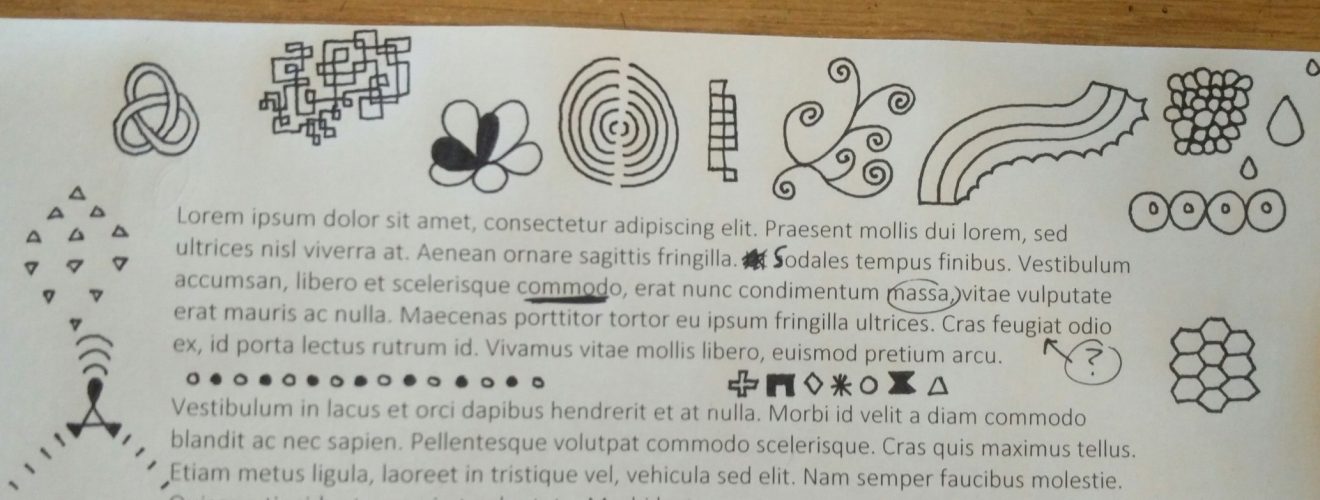What Lurks in the Margins?

It is almost the end of the day, you have drawn more geometric shapes than you have written useful information. Your gaze fixates on the seemingly frozen clock. You are bored, and your automatic response is to start scribbling unpurposeful patterns all over your paper. Furthermore, you are also poised to hide these ink blobs of ill repute from any passing authority figure. It is a universally played out scenario.
Doodling is often seen to be the physical manifestation of a lack of engagement or boredom: it is hardly the activity to flaunt. Even the origin of the word used to mean ‘fool’ or ‘simpleton’. However, a recent experiment alludes that doodling may not be the unproductive time-sapper that it is popularly considered to be, and it may even be beneficial for memory retention and focus.
There have been past attempts to decipher and understand doodling. Sigmund Freud – renowned for his psychoanalysis – hypothesised that a person’s doodles opened a window into their inner psyche and subconscious, although this theory has little scientific backing. The act of doodling remained as mysterious and popularly considered useless until Jackie Andrade – a psychologist at the University of Plymouth – revealed the surprising results of her experiment1.
The experiment was set up with the intention of finding out if doodling improves or hinders attention to a set task. She gathered 40 people and split them into two groups. The two groups were told to listen to a (deliberately) boring and monotonous telephone call of someone describing a fictitious guest list and their responses to a party invite – the task was to note down who is attending the party. One of the two groups was instructed to doodle while completing the task. This involved shading in pre-printed shapes, this ‘non-induced’ doodling ensured the participant would not contemplate the nature of their doodlings – reflection over their creations would taint the results of the experiment. At the end both teams were given a memory test of the contents of the telephone call, the test was kept a surprise so that the participants would not have been inclined to refrain from daydreaming. Surprisingly, the doodlers recalled 29% more information than the non-doodlers2.
Andrade speculates that doodling helps keep the brain from drifting off into a daydream, keeping the mind cruising at an optimum level of focus. You may think the resting brain and daydreaming uses very little of the brain’s resources, but surprisingly, it uses the same amount of energy as when you are focused on a task. The brain never rests, and daydreaming puts to sleep any chance of you remembering that boring lesson you are trapped in. In situations where daydreaming is likely to occur, it seems that doodling provides a relative benefit. It is a case of the lesser of two evils; the destructive effect that daydreaming has on concentration is more powerful than the relatively smaller negative effect of doodling3.
While this study suggests doodling may allow our focus to be secured in specific circumstances, ultimately there is still a lot of research to be performed before we can ascribe doodling to promote the retention of information. A few assumptions may hinder this: shading in geometric boxes might not be a reliable analogue for naturalistic doodling, the group told to doodle may be naturally better at memory retention (regardless of their doodling), and the task was only auditory-based – so the doodling minimally interfered.
When daydreaming is kept forcefully at bay in situations which require constant concentration, then doodling would then lose its relative benefit. This could explain why exam papers seem lacking in colourful scribblings. However, in specific circumstances, such as in laid-back learning situations, then doodling seems to work to one’s benefit. That being said, I would have taken far less time to write this piece if I did not find myself constantly tempted to litter my notes with geometric shapes.
Edited by Katrina Wesencraft










